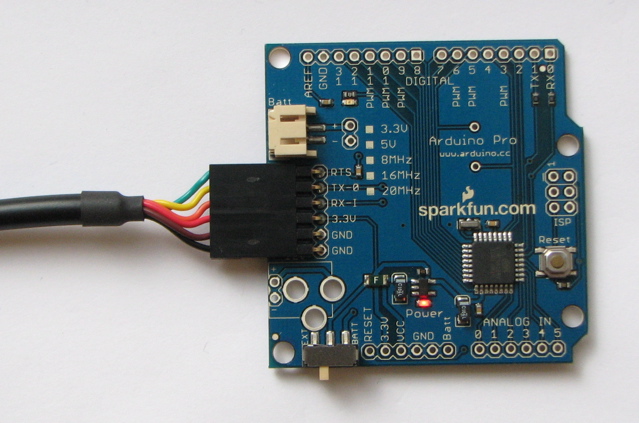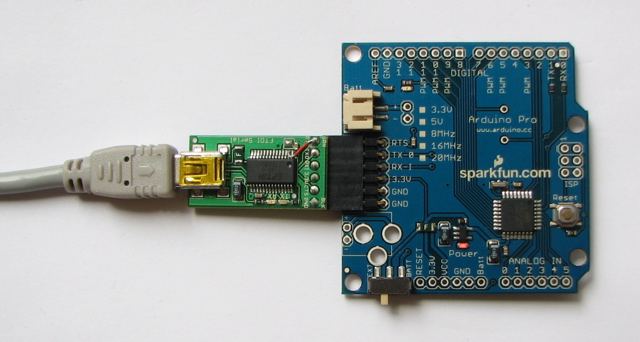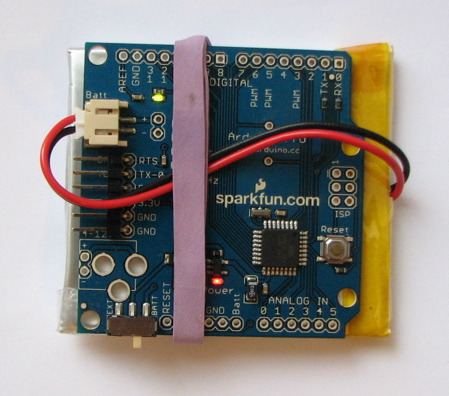Arduino Pro
The Arduino Pro is intended for advanced users who require flexibility and low-cost. It comes with the minimum of components (no on-board USB or pin headers) to keep the cost down. It's a good choice for a board you want to leave embedded in a project. Please note that there are multiple variants of the board which operate at different voltages and clock speeds. You need to know if you have the 3.3V / 8 MHz version or the 5V / 16 MHz version.
Uploading Sketches
The board comes without built-in USB circuitry, so an off-board USB-to-TTL serial convertor must be used to upload sketches. For the 3.3V Arduino Pro boards, this can be a FTDI TTL-232R-3V3 USB - TTL Level Serial Converter Cable or the SparkFun FTDI Basic Breakout Board (3.3V). For the 5V Arduino Pro boards, use a TTL-232R USB - TTL Level Serial Converter or the SparkFun FTDI Basic Breakout Board (5V). (You can probably also get away with using a 5V USB-to-serial convertor with a 3.3V board and vice-versa, but it's not recommended.)
If using the FTDI cable on Windows, you'll need to make one configuration change to enable the auto-reset. With the board connected, open the Device Manager (in Control Panels > System > Hardware), and find the USB Serial Port under Ports. Right-click and select properties, then go to Port Settings > Advanced and check Set RTS on Close under Miscellaneous Options.
For the 3.3V versions of the Arduino Pro, select Arduino Pro or Pro Mini (3.3V, 8 MHz) w/ ATmega328 or Arduino Pro or Pro Mini (3.3V, 8 MHz) w/ ATmega168 from the Tools > Board menu (depending on the microcontroller on your board). For the 5V versions of the Arduino Pro, select Arduino Duemilanove or Nano w/ ATmega328 or Arduino Diecimila, Duemilanove, or Nano w/ ATmega168.

An Arduino Pro connected to (and powered by) an FTDI USB - TTL Level Serial Converter Cable. The green and yellow wires align with the words "green" and "yellow" written underneath the pins.

The Arduino Pro connected to (and powered by) a SparkFun FTDI Basic Breakout Board (prototype version) and USB Mini-B cable.
Power
The external USB-to-TTL serial convertor will power the Arduino Pro, regardless of the position of the switch. To use the board standalone, with no connection to a computer, it can be be powered by a battery or an external power supply (wall wart). You can solder the + and - wires of a battery connector to the corresponding holes on the board. For the 3.3V boards, you can connect a LiPo battery (with JST connector) to the JST jack. Alternatively, solder a DC power jack into the three large holes on the board, and connect a DC power supply (center positive). When the switch is in the "Batt" position, the board will draw power from an attached battery; when it is in the "Ext." position, power comes from an external power supply. In either position, the board can be powered by the 6-pin USB header.

A 3.3V Arduino Pro powered by a 2000 mAh LiPo battery from SparkFun.
Connectors
Any standard 0.1" spaced header can be soldered to the holes on the Arduino Pro. To use every pin requires two 6-pin header and two 8-pin headers. Bare wire can also be soldered directly to the holes. Note that the header spacing is compatible with Arduino shields.
The text of the Arduino getting started guide is licensed under a Creative Commons Attribution-ShareAlike 3.0 License. Code samples in the guide are released into the public domain.